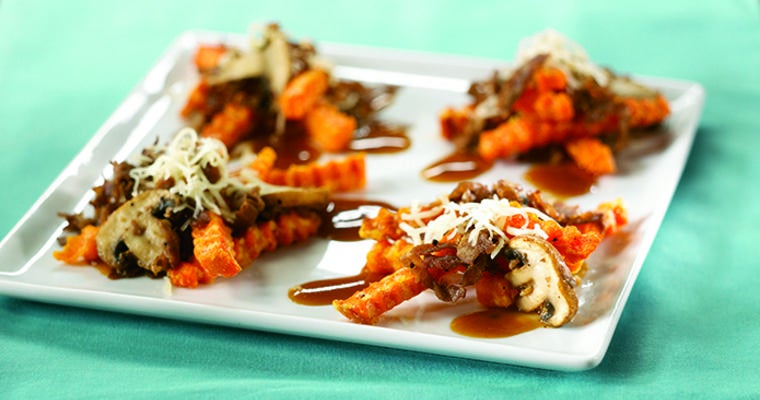A new breed of restaurant is redefining the concept of the classic chophouse. Here, Gordon Food Service Corporate Consulting Chef Gerry Ludwig, CEC, shares his culinary insights on this new trend. His perspective can help operators looking to evolve their steakhouse or other protein-heavy concept. Doug Owens, Gordon Food Service Commercial Segment Manager, offers his operational perspective in this article.
As part of ongoing research into emerging culinary trends, I lead groups of Gordon Food Service customers and employees on annual tours of major metropolitan restaurants that are advancing the industry in fresh and exciting ways. In late 2016, our tour stops included five eateries that are reinventing the traditional steakhouse experience: Boeufhaus, GT Prime and SteakBar in Chicago; Charcoal Venice in Los Angeles; and Quality Eats in New York.
It became evident during our initial tour planning that these restaurants are doing something clearly new and incredibly relevant to changing consumer tastes. Our visits confirmed that perception and convinced me that this is just the start of a trend that will ripple across the country.
While each of these restaurants is taking a distinct approach to this new concept, the common thread is that they’re pushing to differentiate their menus from the classic steakhouse spreads of the past.
Broadly speaking, the culinary characteristics of the classic steakhouse include:
- Very large portions of steak, generally grilled to individual preferences.
- A luxurious shellfish selection, typically served in elaborate towers.
- Rich and indulgent but simply prepared side dishes, such as creamed spinach.
6 characteristics of the new American steakhouse
By contrast, the new American steakhouse differentiates itself through the following culinary principles.
1. The focus is on more than steak. Steak is still center stage, but a much broader range of foods is playing increasingly prominent supporting roles. SteakBar, for instance, offers a very casual, approachable, accessible menu that includes more handheld options than steak entrée selections. While traditional steakhouses rarely venture beyond a beef burger, SteakBar menus shaved prime beef, buffalo chicken, fried whitefish and crab-roll sandwiches, as well as a turkey burger.
GT Prime positions its steak (and seafood) dishes in the middle of its menu, but they’re flanked by an even broader array of non-steak choices arranged in three categories: cold, hot and vegetables. Sliced duck, veal cheeks and crispy chicken thighs are among the choices.
2. Expanded menu parts. The exploration of non-steak dishes is producing much more eclectic and varied menus. SteakBar has a dips, chips and bites category that includes fried-chicken chunks, creamed spinach fondue and a huge platter of steak nachos topped with tomatillo salsa. Quality Eats has introduced a starters section featuring such dishes as sausage-and-pepper toast.
3. An emphasis on sharing plates. One of the most significant dining trends of the past decade has finally made its way to the steakhouse. Operators are creating dishes that are intended for guests to share. The oven-baked oysters at Charcoal Venice and mortadella arancini at GT Prime are sterling examples. Even the steaks are getting in on the act: The 55-day dry-aged ribeye at Boeufhaus is carved into thick slices that make it easy to give everybody a taste.
4. A new approach to vegetables. The veg-centric trend also is being incorporated into new steakhouse menus, as chefs experiment with more creative and boldly flavored vegetable dishes. Increasingly, operators are eliminating the side-dish category altogether, placing their veg-centric offerings elsewhere on the menu, often in a new vegetables section. GT Prime, Quality Eats and Charcoal Venice each offer six to 10 veg-centric selections, ranging from grilled shishito peppers and sweet corn to creamed-spinach hush puppies and cabbage baked in the embers of a charcoal-fired oven.
5. Smaller portions. You can still get a substantial piece of meat at most of these new steakhouses; the Boeufhaus ribeye referenced above weighs in at 22 oz. But the emphasis is definitely on smaller portions—4 oz. to 8 oz. at GT Prime, 6 oz. to 10 oz. at SteakBar and 10 oz. to 14 oz. at Charcoal Venice, for instance. These are often sliced and served at the table, encouraging sharing and the ordering of additional non-steak dishes on the menu.
6. Nontraditional cuts of meat. Today’s most progressive steakhouses aren’t necessarily abandoning sirloin, filet mignon, porterhouse and ribeye steaks. But they are supplementing these traditional favorites with alternative cuts of meat that may require more creative preparation techniques. The Quality Eats menu is perhaps the ultimate expression of this; the steak section includes such nontraditional cuts as bavette, hanger, skirt and flatiron. Charcoal Venice offers a braised short rib that is grilled like a steak. And GT Prime lists lamb loin, venison loin and bison tenderloin alongside its steak selections.
These culinary variations are helping differentiate the next generation of steakhouses from what came before. They also can serve as a useful template for operators seeking to differentiate themselves from the competition.




























